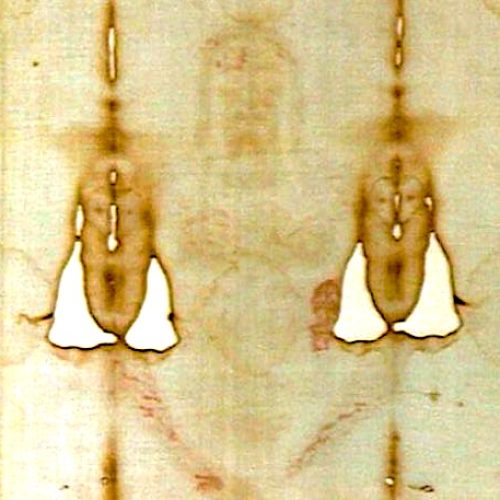On Easter at our church, we explored the authenticity of the Shroud of Turin, purported to be the burial cloth of Christ bearing witness to His death & resurrection (you can go to this page to see the message & the visual resources – southpoint.church/shroud). Those who rule out the supernatural are at a loss to explain how the 3D photographic negative image was burned onto it.
It was American physicist, Dr. John Jackson, who served on the 1978 STURP (Shroud of Turin Research Project) team of scientists, who claimed, “Give me 15 minutes with the shroud & the scientific method, & I’ll prove it’s a hoax.” But after doing all the various tests on the cloth, he became one of the greatest defenders of the Shroud’s authenticity, saying the image would take “several billion watts of light radiation, which exceeds the maximum output of any energy source of UV radiation known today, & its heat would have caused the cloth to vaporize anyway.”
Regardless of relics, Christians can be confident in the truth of the Scriptures which have stood the tests of time & innumerable attacks. Our beliefs don’t need to be validated by the latest scientific studies or archaeological discoveries. But it is a bonus when they substantiate our beliefs.
It is understandable why the Shroud has been doubted. For centuries, forgeries & fakes of so-called sacred relics proliferated, including so many supposed fragments of Christ’s cross that John Calvin remarked in AD 1543 that if all the pieces were gathered, they’d fill a ship! Also floating around were at least 30 nails & various spears claimed to have been used in Christ’s crucifixion, as well as numerous thorns from His crown of thorns, “Holy Grail” chalices from the Last Supper, & burial shrouds. Some were probably just honest misidentifications, while others were exposed as deliberate hoaxes, often painted or stained to mimic blood or an imprint.
While the Shroud’s first historically recorded reference is from AD 1354, it should be noted that an even earlier dated relic known as the Image of Edessa (or Mandylion) is a cloth believed by some to be the Shroud of Turin folded to show only the face. The Shroud’s visible fold marks lend credence to this theory. It’s linked to the Shroud through blood type, stain patterns, & pollen evidence. According to tradition, the Apostle Thaddaeus delivered it to Edessa. Indirect links are made by early historians in AD 325 & 400. The first historical confirmation comes in AD 594.
It was transferred to Constantinople by AD 944, where a sermon in that same year mentions a “side wound” on the image, suggesting a full-body depiction, not just a face. Though skeptics argue the Edessa Image’s connection to the Shroud is only from circumstantial evidence, it’s still compelling & could fill in the Shroud’s timeline gaps (see gotquestions.org/Mandylion.html).
Another plausibly authentic artifact is called the “Sudarium of Oviedo,” which is a bloodstained face cloth with a very faint image, claimed to be that of Jesus. This would have accompanied the Shroud (John 20:6-7). “Sudarium” is Latin for “to sweat,” & refers to a cloth used to wipe sweat or cover the face. It’s kept in Oviedo, Spain & was mentioned in the year AD 570 as being venerated near Jerusalem. To avoid destruction, in AD 614, it was moved northward to Spain.
The blood stains coincide with the Shroud of Turin, & its dirt has a chemical composition nearly identical to that of Calvary. As with the Shroud, pollen grains include species native to the Middle East & linked to the crown of thorns. The linen’s weave is also consistent with 1st-century Jewish burial practices (see shroud.com/guscin.htm).
In 1982, Italian researchers working independently of STURP, using immunological techniques, reported they’d identified the blood type on the Shroud as the relatively rare type AB. Though their findings aren’t universally accepted, what’s noteworthy is that in the 1980s & 90s, researchers analyzed the bloodstains on the Sudarium & found it was the same rare AB type. They also identified what they believe are facial imprints, including marks corresponding to a crown of thorns. The stains suggest the cloth was wrapped around a head post-mortem, with blood & pleural fluid consistent with crucifixion.
The idea that Jesus actually rose from the dead is scandalous to people. It’s equally scandalous to worship a God who allowed Himself to be cruelly crucified as a criminal (1 Cor. 1:18-25). Even some who call themselves Christian refuse to believe because, for them, faith is just an abstract inspirational & moral thing–a personal religious preference. But Jesus didn’t come just to make bad people good, good people better, or secular people spiritual. He came to make dead people live!
Our faith stands or falls on the historicity of the Resurrection (1 Cor. 15:14-20). If it didn’t happen, our faith is worthless & ought to be discarded as silly superstition. But if it did happen, then Jesus really is who He claimed to be & the only way to be made right with God & go to heaven (John 14:6).


